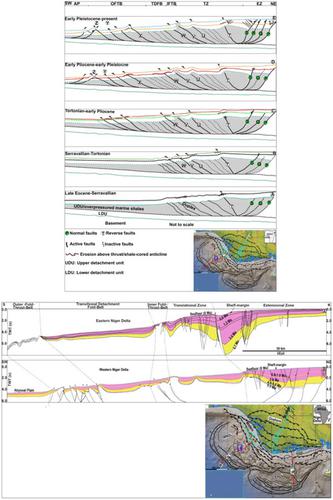当前位置:
X-MOL 学术
›
Basin Res.
›
论文详情
Our official English website, www.x-mol.net, welcomes your feedback! (Note: you will need to create a separate account there.)
Tectono‐stratigraphic evolution of the offshore western Niger Delta from the Cretaceous to present: Implications of delta dynamics and paleo‐topography on gravity‐driven deformation
Basin Research ( IF 3.2 ) Pub Date : 2021-08-30 , DOI: 10.1111/bre.12609 Kelvin Ikenna Chima 1, 2 , Didier Granjeon 3 , Damien Do Couto 1 , Estelle Leroux 4 , Christian Gorini 1 , Marina Rabineau 5 , Jean Letouzey 1 , Nick Hoggmascall 6 , Miguel‐Mora Glukstad 7
Basin Research ( IF 3.2 ) Pub Date : 2021-08-30 , DOI: 10.1111/bre.12609 Kelvin Ikenna Chima 1, 2 , Didier Granjeon 3 , Damien Do Couto 1 , Estelle Leroux 4 , Christian Gorini 1 , Marina Rabineau 5 , Jean Letouzey 1 , Nick Hoggmascall 6 , Miguel‐Mora Glukstad 7
Affiliation

|
The interaction between sedimentary wedge dynamics and paleo-fracture zones is investigated offshore western Niger Delta lobe (WNDL) to reconstruct the evolution of the delta from the Cretaceous to present. This was achieved through detailed regional seismic interpretation, calibrated with well data. Our results suggest that high sedimentation rates in the WNDL since the Serravallian–Tortonian triggered the migration of the ‘Oligocene-Tortonian extensional zone’ and gravity spreading seawards (from a present-day onshore to a present-day offshore position), with extensional, translational and contractional deformation. An additional increase in sedimentation rate since the early Pliocene, further accelerated gravity spreading and the development of the present-day contractional front. A five-stage tectono-stratigraphic evolution of the offshore WNDL from the late Cretaceous to present is proposed. Paleo-topographies formed by the Charcot and Chain Fracture Zones exerted depositional control on the stratigraphic architecture of the offshore WNDL from the Cretaceous to Serravallian. Differential subsidence on both sides of the relict Charcot and Chain transform faults is responsible for the segmentation of gravity-driven deformation of the eastern and western Niger Delta lobes. In addition, a comparison of the stratigraphic architecture of the eastern Niger Delta lobe (ENDL) and WNDL demonstrates a similar overall progradation and sediment bypass to the deep basin during the Pliocene. During the Pleistocene, the two lobes show a distinct evolution and architecture: the ENDL shows an overall retrogradation and sediment sequestration on the shelf, whereas the WNDL displays an overall progradation and sediment bypass. This study documents long-term and large-scale control of delta dynamics and paleo-topography on gravity-driven deformation of the offshore eastern and western Niger Delta lobes, and similar analysis could be applied in the reconstruction of other passive margin basins.
中文翻译:

尼日尔三角洲西部从白垩纪至今的构造地层演化:三角洲动力学和古地形对重力驱动变形的影响
研究了沉积楔动力学与古断裂带之间的相互作用,以重建从白垩纪到现在的三角洲西部的演化。这是通过详细的区域地震解释和井数据校准来实现的。我们的研究结果表明,自 Serravallian-Tortonian 以来,WNDL 的高沉积速率引发了“渐新世-Tortonian 伸展带”的迁移和重力向海扩散(从现在的陆上位置到现在的海上位置),随着伸展,平移和收缩变形。自上新世早期以来,沉积速率的进一步增加,进一步加速了重力扩散和当今收缩锋的发展。提出了近海WNDL从晚白垩世到现在的五期构造-地层演化。夏科断裂带和链断裂带形成的古地形对白垩纪至塞拉瓦利亚近海西北部的地层结构施加了沉积控制。残存的夏科和Chain转换断层两侧的差异沉降是尼日尔三角洲东部和西部裂片的重力驱动变形分割的原因。此外,尼日尔三角洲东部(ENDL)和WNDL的地层结构的比较表明,在上新世期间,向深盆地的整体推进和沉积物旁路相似。在更新世期间,两个裂片显示出明显的演变和结构:ENDL 显示了陆架上的整体回生和沉积物封存,而 WNDL 显示了整体的进积和沉积物旁路。本研究记录了三角洲动力学和古地形对尼日尔三角洲东部和西部近海叶瓣重力驱动变形的长期和大规模控制,类似的分析可以应用于其他被动边缘盆地的重建。
更新日期:2021-08-30
中文翻译:

尼日尔三角洲西部从白垩纪至今的构造地层演化:三角洲动力学和古地形对重力驱动变形的影响
研究了沉积楔动力学与古断裂带之间的相互作用,以重建从白垩纪到现在的三角洲西部的演化。这是通过详细的区域地震解释和井数据校准来实现的。我们的研究结果表明,自 Serravallian-Tortonian 以来,WNDL 的高沉积速率引发了“渐新世-Tortonian 伸展带”的迁移和重力向海扩散(从现在的陆上位置到现在的海上位置),随着伸展,平移和收缩变形。自上新世早期以来,沉积速率的进一步增加,进一步加速了重力扩散和当今收缩锋的发展。提出了近海WNDL从晚白垩世到现在的五期构造-地层演化。夏科断裂带和链断裂带形成的古地形对白垩纪至塞拉瓦利亚近海西北部的地层结构施加了沉积控制。残存的夏科和Chain转换断层两侧的差异沉降是尼日尔三角洲东部和西部裂片的重力驱动变形分割的原因。此外,尼日尔三角洲东部(ENDL)和WNDL的地层结构的比较表明,在上新世期间,向深盆地的整体推进和沉积物旁路相似。在更新世期间,两个裂片显示出明显的演变和结构:ENDL 显示了陆架上的整体回生和沉积物封存,而 WNDL 显示了整体的进积和沉积物旁路。本研究记录了三角洲动力学和古地形对尼日尔三角洲东部和西部近海叶瓣重力驱动变形的长期和大规模控制,类似的分析可以应用于其他被动边缘盆地的重建。



























 京公网安备 11010802027423号
京公网安备 11010802027423号